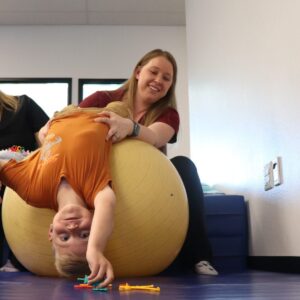What is Core Stability?
What is our core? Our core muscles include the abdominal and trunk muscles which make up the center (core) of our body. Core stability is achieved when our core muscles work together to create stability to allow for coordinated movement.
Core stability is important for all positions and movements, both stationary and dynamic. It is important for children to have core stability so that they are able to sit upright in school, and when they are eating or playing. Our core muscles allow us to have good posture in sitting and standing, and also allow us to move our arms and legs in a coordinated manner. Dynamic tasks such as walking and obstacle navigation require stability and the contraction of core muscles to allow our limbs to move freely. The ability of our core muscles to work collectively to create a stable base for our body is essential for safe and controlled dynamic movement.
Here are a few signs of potential core weakness:
-
- Rolling onto stomach or side to sit up from the floor
- Decreased balance reactions: Difficulty coordinating the timing between activating the abdominals and back muscles to react to sudden changes in movement
- Always on the move and have difficulty staying still
- Preference for a wide base of support
- W-sitting or long sitting are examples of sitting postures often used to achieve increased stability through a widened base of support. As a result, the core muscles do not have to work as hard to maintain the position
- Poor posture: Poor endurance of core muscles and having difficulty keeping core muscles activated
- Slumping forward and extending their head/neck to see their environment
- Constantly leaning into support surfaces to maintain balance
Here are a few ways to improve core stability and strength for kids:
-
- Playing a game in stationary postures: sitting, kneeling, and standing. It is important to practice both stationary and dynamic activities in order to build core stability
- Have your child sit in a side-sit or criss-cross position to reduce their base of support and encourage core activation in comparison to a w-sit or long sit position
- Place toys at eye level during a stationary sitting or standing activity to promote core engagement and an upright posture
- Animal walks are a fun great way to help your child develop dynamic core strength and stability
- Climbing across obstacle courses, climbing a wall ladder, or crawling up and down stairs are great dynamic activities to build a strong core
- Perform activities on a therapy ball!
For more activities to help your kiddos build core stability, click here. Our core muscles make up the foundation of our body, and it is essential for kids to have a strong and stable core to build and develop skills.
If you think your child may benefit from a skilled pediatric therapist, please reach out to us here at Kids Place Pediatric Therapy in Arizona.








